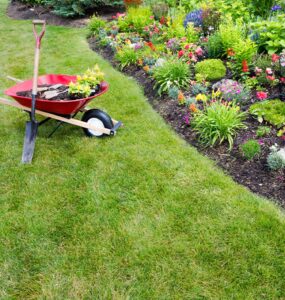Early Spring Lawn Care
by Rob Sproule
Lawns make up the majority of most of our yards. Even though more people are replacing lawns with perennials beds and edible gardens, turf care is still paramount in our gardening minds. As we enter our long goodbye with winter and embrace our too short summer, here are some tips for a lush, healthy turf.
Resist Temptation
As the snow pack recedes and your lawn beckons to you from under puddles, the temptation begins! For many eager gardeners, the first instinct is a grab a rake and leap into the fray, raking hard even while the thatch is still caked with ice.
Resist the temptation. Working your lawn while it’s still wet can do more harm than good. Your heavy feet can compact wet soil and break off emerging new shoots, which will lead to sparse grass and give germinating weeds a head-start.
Snow mould, or Typhula blight, is common after our snowy winters. It’s unsightly, with the fungus forming silvery-grey circular patches on the lawn, approximately 10-30cm wide. It can wreak havoc on your allergies but it will quickly dry up as the lawn dries off. Unless it’s thick enough that it can choke out the grass, I wouldn’t bother raking it off.
While you’re waiting for the lawn to dry, consider sharpening your mower blades. Blades that are sharpened annually will shear a smooth edge off the grass instead of tearing it, which will lead to healthier turf. Remember to change the oil, spark plug, and filters while you’re at it.
If you’re keen, and impatient, spread leftover snow piles (in those shady spots) into the sun for quicker melting. On top of this allowing the lawn to dry out sooner, and more evenly, it will also reduce snow mould in the shadier spots.
Raking and Top-Dressing
“Spring” in to action once the thatch has dried. Give a good rake, especially with older lawns and especially if you have a half-inch or more of old thatch. Excessive thatch is a breeding ground for sod-webworm, powdery mildew, and other common ailments.
Put some back into it! You don’t need to clear all the thatch, but try to work it down to a quarter inch or so. Then top dress any sparse areas quickly before the weed seeds have a chance to germinate (thatch helps keep them down, as well).
To top dress, throw a quarter to half inch of potting soil (or mix black dirt with peat moss and sand) across sparse patches. The organic nutrients in the soil will revitalize the lawn for the growing season. Top seed over the soil to desired thickness. If you have hungry birds around, dust more soil over the seed to disguise their lunch.
Aerating the lawn, whether you rent a machine yourself or hire a company, is about pulling about plugs to give cramped root systems some air. It’s great for long-term turf health, especially on older and/or compacted lawns (with high for traffic).
Fertilizing
Grass doesn’t wake up as soon as the snow melts. It’s dormant for a while, and fertilizing a dormant lawn not only wastes money, it actually works against you by providing easy nitrogen for germinating weed seeds, which wake up earlier.
Wait until your grass to green and growing to fertilize. Eager gardeners need to patient, because this is often a while after the snow melts (April weather depending).
The days of fertilizing with a high-nitrogen mix in one hand and a hose in the other are, thankfully, over. Most blends are slow release now, breaking down slowly over weeks or months and not requiring water to prevent burning.
















